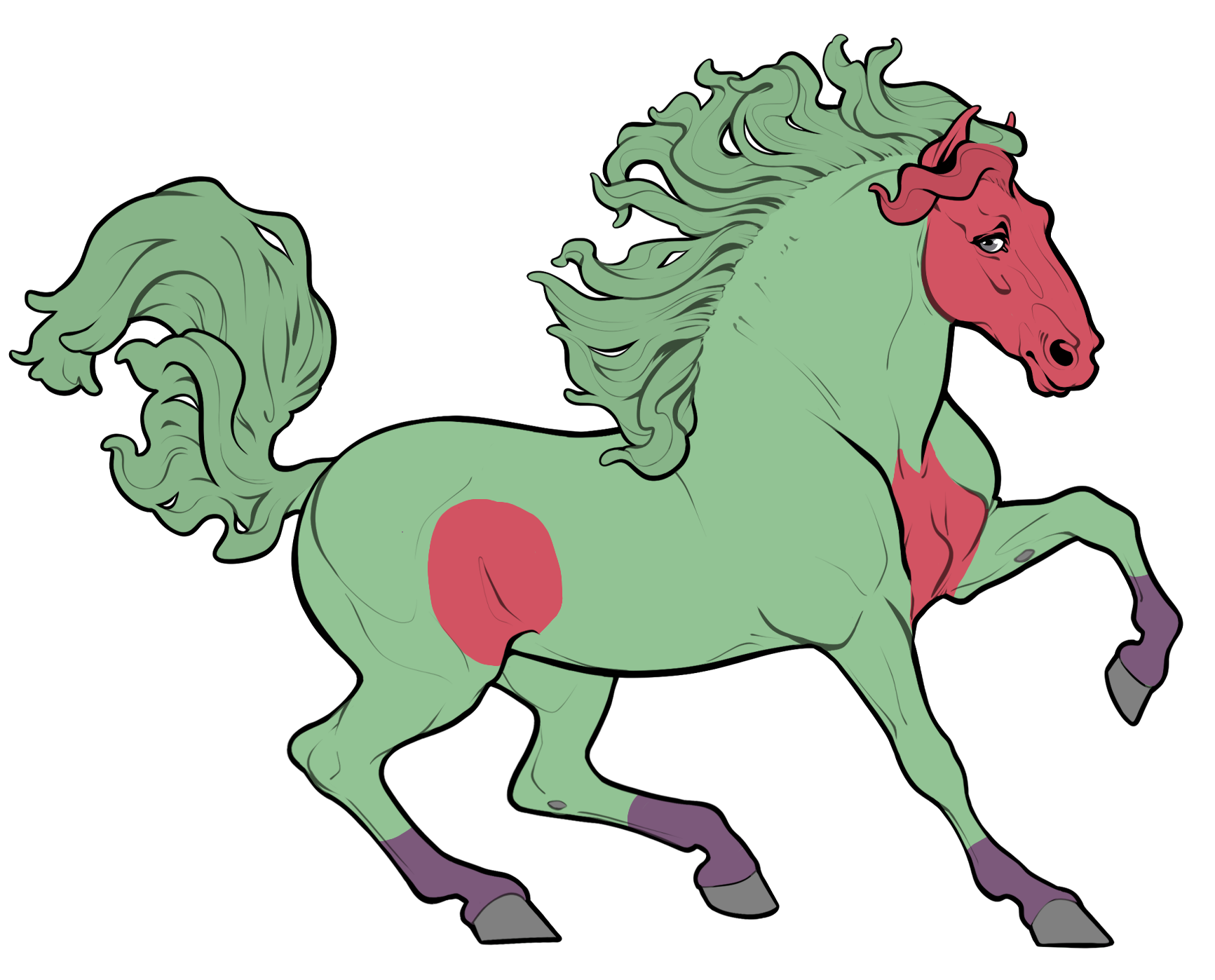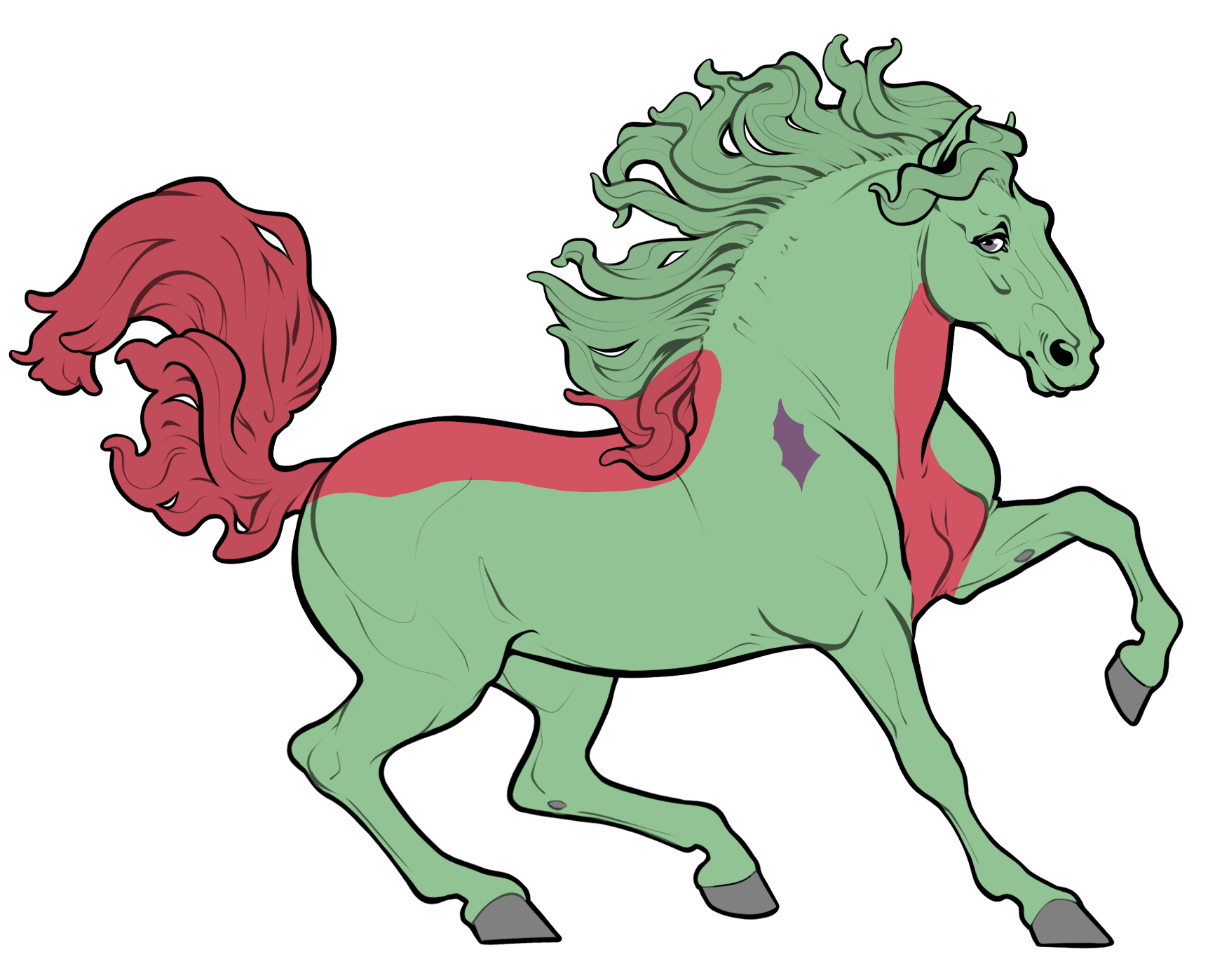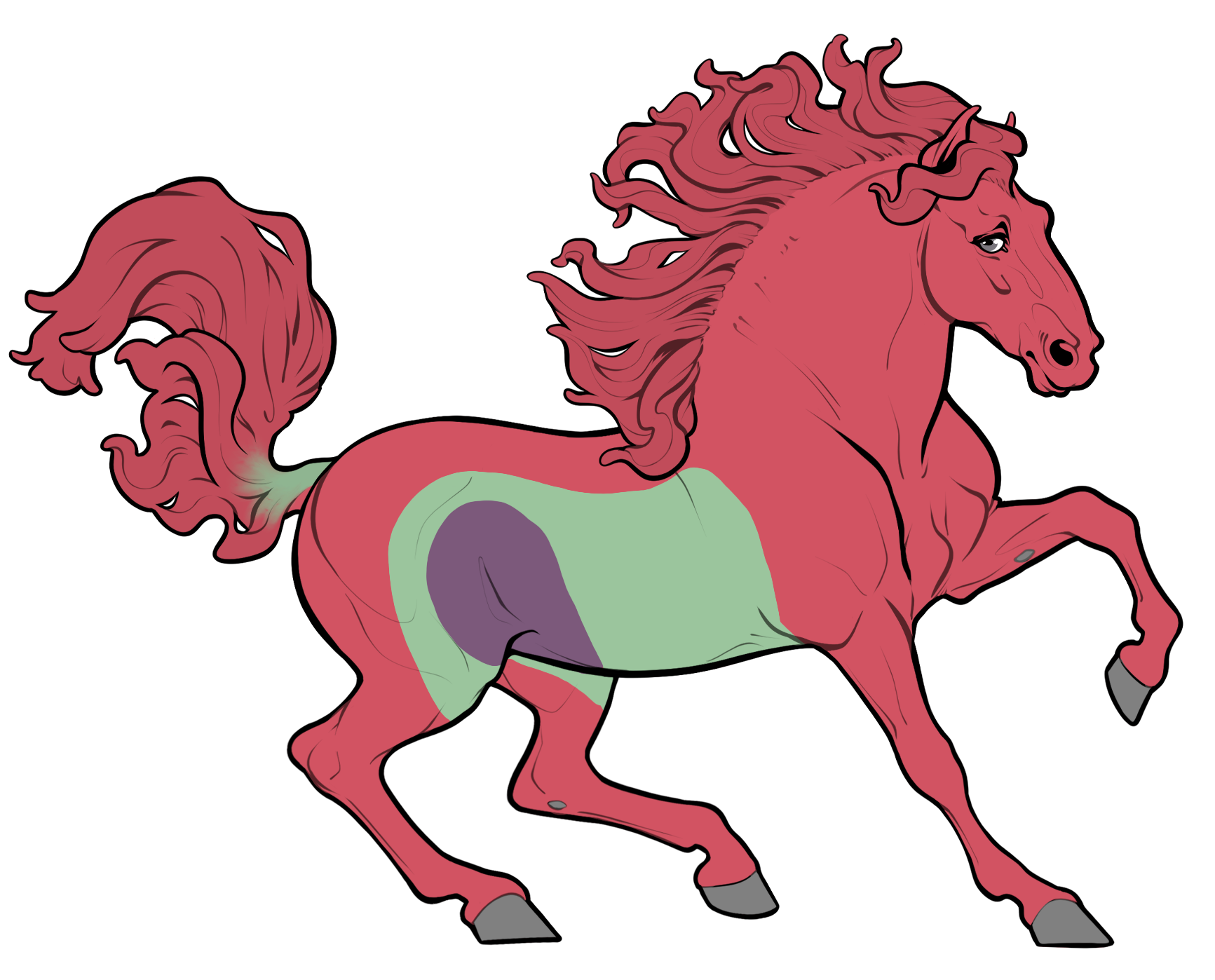Traits



Cuirass is a white marking that appears on a Courser's chest and resembes an armored breastplate.
It is always present on the upper half of the chest, but can spread over the shoulders, neck and barrel.
Cuirass will never touch the mane or cross the topline. It will never touch the belly or "connect" behind the forelegs.
Scalloped edges and unnatural patterns and shapes are possible, but should not be so intricate as to resemble Filigree.
Though large cut-outs are possible, Cuirass will never have holes, spots, or disconnected areas.
Cuirass markings are always perfectly symmetrical.
Genotype: Cu_
Locus: Shares a locus with Crowned.
- Coat: Cuirass is a white marking.
- Mane and Tail: Not affected.
- Skin: Not affected.
- Eyes: Not affected.
- Hooves: Not affected.
Range:
- Minimum: White marking covering the upper half of the chest and extending at least to middle of the shoulder.
- Maximum: White marking covering entire chest and front of the neck, from the bottom of the pectorals to the throatlatch. Will never reach the top of the neck/mane, the belly, or past the front third of the barrel.
Interactions:
- Filigree: All modifications made to a Cuirass marking by Filigree will be symmetrical.



Harlequin is a white marking that presents as a series of vaguely diamond-shaped markings connected at the corners.
Harlequin tends to "radiate out" from a single place, with rings of connected diamonds all pointing towards one point, usually the poll or the croup.
Diamond markings vary in size but must be no smaller than the horse's eye and no larger than the horse's head.
Diamonds may be disconnected from the rest of the Harlequin pattern as long as they are oriented in the same direction as the rest of the marking.
Most diamonds should be connected, however "breaks" or gaps in rings of diamonds are acceptable.
Harlequin markings will never have jagged edges, holes, or spots.
Genotype: Hq_
Locus: Not shared with any known genes
- Coat: Harlequin is a white marking.
- Mane and Tail: White where touching marking.
- Skin: Pink under marking.
- Eyes: Can cause blue eyes.
- Hooves: Not affected.
Range:
- Minimum: Two white diamond-shaped markings connected at the corners. The diamonds must be somewhere on the barrel or neck, and must be at least the size of the horse's eye.
- Maximum: A pattern of diamonds that covers the entire neck, head, barrel, and hindquarters. Up to two legs (either both forelegs or both hind legs) may have diamond markings.
Interactions:
- Chimera & Somatic: Chimera and Somatic markings have an unusual tendency to "fill" the spaces between Harlequin diamonds. Additionally, horses with both Harlequin and the Chimera anomaly can sometimes display two different colors of Chimera markings.
Genetic Info
Locus: Blanched, False Leopard


(Images from left to right: Minimal Blanched on Chestnut, Maximum Blanched on Chestnut )
Blanched is a white marking that presents as lightening of the coat on the face and legs, like an inverse of Roan.
Blanched can be a subtle lightening of the base color or bold white.
Blanched should blend evenly and gradually into the coat.
Unless False Leopard is present, Blanched will not have holes or spots.
- Interactions:
- False Leopard: When Blanched and False Leopard are both present, False Leopard creates holes in Blanched markings rather than creating new lightened areas.
- Roan: When Blanched and Roan are both present, Roan can be hidden.
- Filigree and Kintsugi: Filigree and Kintsugi do not interact with Blanched.
Blanched's effects on:
- Coat Color: Blanched is a white marking.
- Mane & Tail Color: Blanched does not affect the mane and tail.
- Skin Color: Blanched does not affect skin color.
- Eye Color: Blanched does not affect eye color.
- Hoof color: Blanched does not affect hoof color.
Blanched Range
Genetic Info
Locus: Not shared with any known genes



(Images from left to right: Filigree on Chestnut Tobiano, Filigree on Chestnut with Free White, Filigree on Chestnut Snowcap)
Filigree is a white marking that appears as elegant swirls that branch out of other white markings, including free white.
Filigree must be attached to another white marking.
Filigree will always reach "out" of other markings, and will never "cut in" to them or make them smaller.
Filigree may reach across from one marking to another, connecting them. (ie: Tobiano and Splash)
Filigree will not appear along edges created by somatic.
Filigree can be completely hidden, and does not have to interact with all white markings present.
Filigree will always have crisp, smooth edges.
Filigree may have minimal free floating bits (such as dots or flourishes) that act as accents, so long as they remain near the edge of the full connected marking no more than the space of an eye away. It should never appear to be creating its own new white marking on the horse that is not connected to an existing white marking.
- Cuirass, Crowned, Shroud: All modifications made to a Cuirass, Crowned, and/or Shroud marking by Filigree will be symmetrical.
- Ossuary: Modifications made to an Ossuary marking by Filigree may be symmetrical although it is not required.
- Roan, Blanched, False Leopard, Rabicano: Filigree does not interact with white markings that have blended, gradual, or gradient edges.
- Dom White, Sabino, Varnish Roan, Few Spot, Snow Cap: Filigree will always come off the main body of the marking and will be unaffected by broken, speckled or grainy edges. It will not create swirls off of freckles on the coat.
- Vitiligo: Filigree does not interact with Vitiligo as it is a lack of pigmentation in the skin and hair and not a white marking.
Filigree's effects on:
- Coat Color: Filigree is a white marking.
- Mane & Tail Color: Mane and tail will be white where marking touches.
- Skin Color: Filigree will turn skin light pink underneath the white marking.
- Eye Color: Filigree does not affect the eye color.
- Hoof color: Filigree will turn hooves cream or light tan where touching.
Filigree Range




Crowned is a white marking (or group of markings) on top of a Courser's head.
Crowned is always vaguely symmetrical, and may be made of a single marking (with or without cut-outs) or an arrangement of small markings.
The shapes making up Crowned may be "unnatural" should be simple: stripes, spots, or splotches.
Crowned should not appear overly intricate so as to resemble Filigree. Crowned will never resemble religious symbols or lettering.
The edges of Crowned may be crisp or gradually blended into the base coat.
Genotype: Cw_
Locus: Shares a locus with Cuirass.
- Coat: Crowned is a white marking.
- Mane and Tail: Not affected.
- Skin: Pink under marking.
- Eyes: Not affected.
- Hooves: Not affected.
Range:
- Minimum: A symmetrical marking on the forehead, at least the size of the horse's eye.
- Maximum: A symmetrical marking that covers the forehead, ears, and cheeks, but does not reach the muzzle.
Interactions:
- Filigree: All modifications made to a Crowned marking by Filigree will be symmetrical and have crisp, unblended edges.



Genetic Info
Locus: Not shared with any known genes.



(Images from left to right: Chestnut Splash with a more minimal visual expression, Chestnut Splash with a mid range expression, Chestnut Splash with a more maximum expression)
Splash can be totally hidden.
It can also cause high white on one or all legs, or the spreading of face markings.
Splash's borders should be crisp and somewhat jagged, without holes or cut-outs.
If Splash only touches the bottom of the tailbone, it may cause only the bottom half of the tail to be white.
Splash's effects on:
- Coat Color: Splash is a white marking.
- Mane & Tail Color: Will be white where touching marking.
- Skin Color: Splash will turn skin light pink underneath the white marking.
- Eye Color: Splash can cause blue eyes, even if the marking is not touching the face.
- Hoof color: Splash will turn hooves cream or light tan where touching.
Splash Range
Genetic Info
Locus: Roan is a KIT gene mutation, along with Tobiano, Sabino, and Dominant White. A horse may carry only two KIT gene mutations.



(Images from left to right: Minimal Roan on Chestnut, Light Roan with Corn Marks on Chestnut, Intense Roan on Chestnut.)
It may cause a light, grayish appearance compared to the base color or turn the coat nearly white.
"Corn Marks" may form allowing the base coat color showing through.
Roan should fade gradually into the base color at its edges.
- Definitions:
- Corn Marks: Small marks throughout the roan where the base coat may show through. These marks should be no bigger than a horse's iris and should not appear symetrical or intentional. They should never mimic false leopard in appearance.
- Interactions:
- Blanched: When Blanched and Roan are both present, Roan may be hidden.
- Filigree and Kintsugi: Filigree and Kintsugi do not interact with Roan.
- Chestnut: When Roan is on a Chestnut base coat, it is often colloquially known as "Red Roan."
- Black: When Roan is on a Black base coat, it is often colloquially known as "Blue Roan."
Roan's effects on:
- Coat Color: Roan is a white marking.
- Mane & Tail Color: Roan does not affect the mane and tail.
- Skin Color: Roan does not affect skin color.
- Eye Color: Roan does not affect eye color.
- Hoof color: Roan does not affect hoof color.
Roan Range
Genetic Info
Locus: Tobiano is a KIT gene mutation, along with Roan, Sabino, and Dominant White. A horse may carry only two KIT gene mutations.
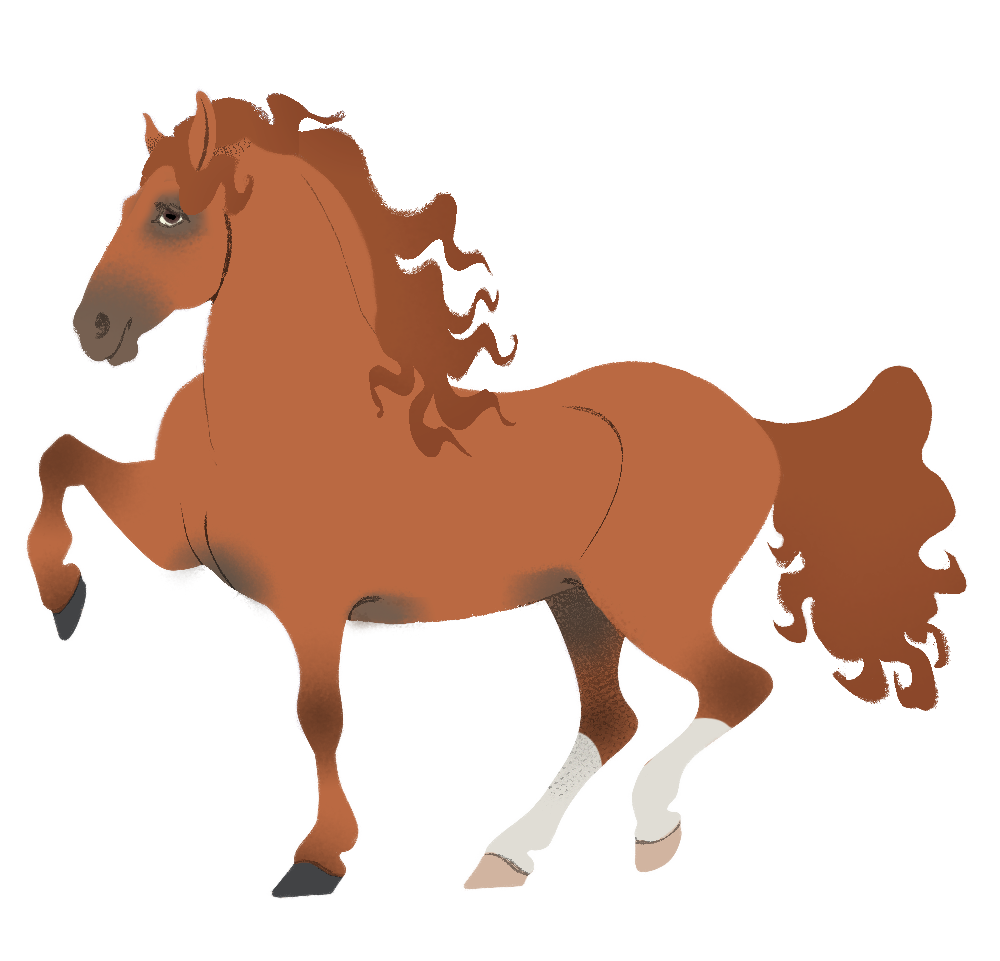


(Images from left to right: Chestnut Tobiano with a minimal visual expression, Chestnut Tobiano with a mid range expression, Chestnut Splash with a maximum expression)
Tobiano will not cause irregular face markings.
"Cat tracks" or small holes in Tobiano markings are common.
Tobiano should have crisp, smooth curved edges.
It will not have disconnected spots of white that do not touch the topline.
- Definitions:
- Cat Tracks: Small holes or cut outs no bigger than a horse's hoof that may appear in tobiano markings, allowing the base coat to show through. Cat tracks are most often found along the edges of the tobiano marking. They cannot create floating white markings around the tobiano.
- Cat Tracks: Small holes or cut outs no bigger than a horse's hoof that may appear in tobiano markings, allowing the base coat to show through. Cat tracks are most often found along the edges of the tobiano marking. They cannot create floating white markings around the tobiano.
- Interactions:
- with Overo: When tobiano and overo are both present, it is often colloquially known as 'tovero'.
Tobiano's effects on:
- Coat Color: Tobiano is a white marking.
- Mane & Tail Color: Mane and tail will be white where tobiano touches; a gradient effect is possible if only part of the tail is affected by tobiano.
- Skin Color: Tobiano will turn skin light pink underneath the white marking.
- Eye Color: Tobiano does not affect the eye color.
- Hoof color: Tobiano will turn hooves cream or light tan where touching.
Tobiano Range



Snowflake is a white marking that expresses as small white dots over a horse's body.
Placement of Snowflake spots is mostly random, though concentrations over a particular part of the barrel or neck are common.
Spots may vary in size, but in general should not be larger than the horse's eye.
Dense patches of small spots are possible, but should not resemble Roan.
Genotype: nLp
Locus: Snowflake is part of the Leopard Complex group of patterns, along with Snowcap, Blanket, Leopard, Varnish Roan, and Fewspot.
- Coat: Snowflake is a white marking.
- Mane and Tail: May turn white where touching marking.
- Skin: May cause pink speckled skin.
- Eyes: Not affected.
- Hooves: May cause tan-striped hooves.
Range:
- Minimum: A few sparse white spots scattered over the body at random above the hocks/knees.
- Maximum: Dense white spots over the body above the hocks/knees that vary in size and seem to "flow" in a similar direction.
Genetic Info
Locus: Not shared with any known genes.

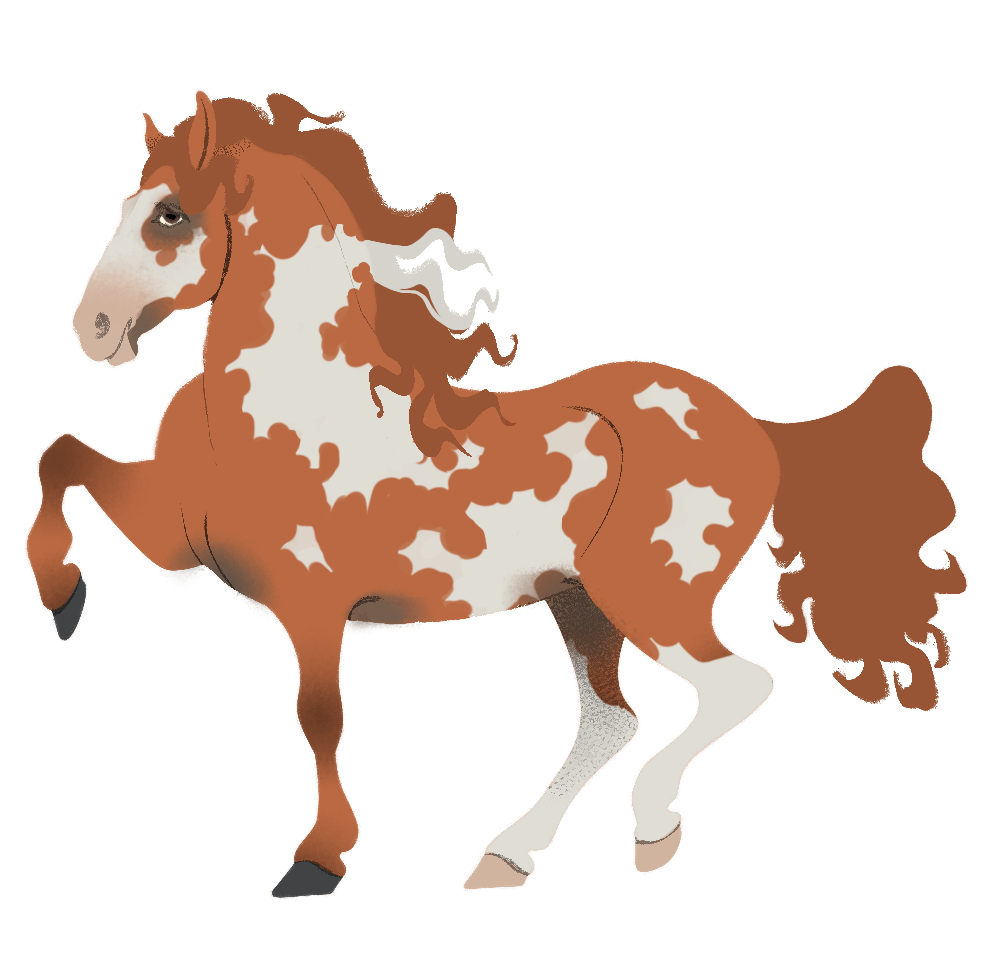

(Images from left to right: Chestnut Overo with a more minimal visual expression, Chestnut Overo with a more maximum expression, Chestnut Overo with a more mid range expression)
It usually appears on the side of the barrel and spreads outwards to the "edges" of the body.
Overo rarely affects the legs, and tends to spread on the side of the leg closest to the belly.
Overo causes irregular spreading of face markings, and can create bald face or badger face markings.
Overo should have crisp edges, which may be smooth or jagged. Overo should not have holes within it's markings.
- Tobiano: When Tobiano and Overo are both present, it is often colloquially known as 'Tovero'.
- ❗ Lethal White: Homozygous Overo (OO) and/or the combination of Overo and Ossuary (nO nOs) result in a fatal condition known as 'Lethal White Syndrome.' If a breeding results in a foal with OO or nO nOs, that foal cannot be born. Slots and items will still be consumed, so plan your breedings with care!
Additional Notes:
- Badger Face: A distinctive marking that resembles a "reverse blaze" with the base coat showing on the front of the face and white on either side.
- Bald Face: A white marking that covers most or all of the face.

Badger Face

Bald Face
Overo's effects on:
- Coat Color: Overo is a white marking.
- Mane & Tail Color: Mane will be white where marking touches. Overo cannot touch the tail.
- Skin Color: Overo will turn skin light pink underneath the white marking.
- Eye Color: Overo can make the eyes blue, even if the marking does not touch them.
- Hoof color: Overo will turn hooves cream or light tan where touching.
Overo Range



Blanket is a white marking that expresses as a spotted patch of white on the horse's croup.
Blanket spots are randomly placed and vary in size, but in general should not be larger than the horse's hoof.
Blankets may be surrounded by patches of coat that are lightened (resembling Roan) or occasional spots darker than the base color (see examples below).
Genotype: nLp patn
Locus: Blanket is part of the Leopard Complex group of patterns, along with Snowflake, Snowcap, Leopard, Varnish Roan, and Fewspot.
- Coat: Blanket is a white marking.
- Mane and Tail: Typically unaffected, though white hair or white roots where touching are acceptable.
- Skin: May cause pink speckled skin.
- Eyes: Not affected.
- Hooves: May cause tan-striped hooves.
Range:
- Minimum: A spotted white patch visible on the top third of the hindquarters.
- Maximum: Spotted white that covers the hindquarters and barrel as far forward as the withers. May affect the legs in irregular strips/patches or cause irregular white markings. The base coat will show on the face, neck, chest, and shoulders.






Leopard is a white marking that covers the body, with the base coat showing through in a spotted pattern.
Spots are randomly placed but should affect the entire body and be visibly more numerous than Fewspot.
Spots vary in size, but in general should be about the size of the horse's eye and never larger than the horse's head.
Genotype: nLp patnpatn
Locus: Leopard is part of the Leopard Complex group of patterns, along with Snowflake, Snowcap, Blanket, Varnish Roan, and Fewspot.
- Coat: Leopard is a white marking.
- Mane and Tail: White except where touching spots. May create a gradient effect on the tail.
- Skin: May cause pink speckled skin; skin will be pink wherever white touches.
- Eyes: Not affected.
- Hooves: May cause tan-striped hooves.
Range:
- Minimum: A white coat with the base color showing through in sparse spots all over the body.
- Maximum: A white coat with the base color showing through in large, dense spots all over the body.






Snowcap is a white marking that expresses as a patch of white on the horse's croup.
Unlike Blanket, Snowcap is solid white, though there may be spots and speckles at its edges.
Genotype: LpLp patn
Locus: Snowcap is part of the Leopard Complex group of patterns, along with Snowflake, Blanket, Leopard, Varnish Roan, and Fewspot.
- Coat: Snowcap is a white marking.
- Mane and Tail: Not affected, mostly. White roots on the tail are acceptable.
- Skin: May cause pink speckled skin.
- Eyes: Not affected.
- Hooves: May cause tan-striped hooves.
Range:
- Minimum: A white patch visible on the top third of the hindquarters.
- Maximum: Patch of white that covers the barrel as far as the withers. Will not reach below the hocks on the hind legs, and will not affect the front legs at all. Has no effect on other white markings.






Varnish Roan is a white marking that covers the body in irregular, speckled white.
Unlike Roan, Varnish can appear anywhere on the horse and is irregular in density, often with patches of base coat showing through on the neck, cheeks, shoulders, and hindquarters.
Spots of base color can show through Varnish Roan in a pattern that resembles Blanket or Leopard.
Genotype: LpLp
Locus: Varnish Roan is part of the Leopard Complex group of patterns, along with Snowflake, Snowcap, Blanket, Leopard and Fewspot.
- Coat: Varnish Roan is a white marking.
- Mane and Tail: Not affected, mostly. White roots are acceptable.
- Skin: May cause pink speckled skin.
- Eyes: Not affected.
- Hooves: May cause tan-striped hooves.
Range:
- Minimum: A speckled white patch that covers the hindquarters and barrel, with irregular lightening and texture that differentiates it from Snowcap or Blanket.
- Maximum: A white "varnish" over the body that is patchy/speckled at the tops of the legs, the neck, the cheeks, and the top of the muzzle. Speckles or spots of base coat may show through.






Fewspot is a white marking that covers the body, with the base coat barely showing through at all.
Only a small number of spots are possible, and should be mostly located on the hocks/knees, fetlocks, groin and elbow areas.
Color around the muzzle and eyes is possible. Spots should never be larger than the horse's eye.
Genotype: LpLp patnpatn
Locus: Fewspot is part of the Leopard Complex group of patterns, along with Snowflake, Snowcap, Blanket, Leopard, and Varnish Roan.
- Coat: Fewspot is a white marking.
- Mane and Tail: White except where touching spots. May create a gradient effect.
- Skin: May cause pink speckled skin.
- Eyes: Not affected.
- Hooves: May cause tan-striped hooves.
Range:
- Minimum: A white body with only a few small freckles of visible base color near the elbows or groin.
- Maximum: A white body with speckled color visible on the knees, hocks, groin and elbow areas, and near the eyes and muzzle, with a small number of freckles visible on the body.
Genetic Info
Locus: Sabino is a KIT gene mutation, along with Roan, Tobiano, and Dominant White. A horse may carry only two KIT gene mutations.



(Images from left to right: Chestnut Sabino with a more minimal visual expression, Chestnut Sabino with a mid range expression, Chestnut Sabino with a maximum expression)
Sabino has jagged, speckled edges. Minimal Sabino has crisp, clear edges,
but higher-coverage Sabino causes Roan-like lightening and gradual edges.
As Sabino spreads, it remains more dense/extensive on the underside of the body.
Sabino causes irregular spreading of face markings, and can create bald face markings.
- Badger Face: A distinctive marking that resembles a "reverse blaze" with the base coat showing on the front of the face and white on either side.
- Bald Face: A white marking that covers most or all of the face.
- Gulastra Plume: A white or partially-white tail with no other white visible on the body.

Badger Face

Bald Face

Gulastra Plume
Sabino's effects on:
- Coat Color: Sabino is a white marking.
- Mane & Tail Color: Mane will be white where marking touches. Gradients or white roots are acceptable.
- Skin Color: Sabino will turn skin light pink underneath the white marking.
- Eye Color: Sabino does not affect the eye color.
- Hoof color: Sabino will turn hooves cream or light tan where touching.
Sabino Range
Genetic Info



(Images from left to right: Maximum Dominant White, Dominant White on Chestnut, Minimal Dominant White Expression)
White spreads up from the bottom of the horse, and some of the base color may show at the topline.
When Dominant White has visible edges, they are usually roaned and grainy, similar to Sabino.
- ❗ Lethal White: Homozygous Dominant White (WW) results in a fatal condition known as 'Lethal White Syndrome.' If a breeding results in a foal with WW, that foal cannot be born. Slots and items will still be consumed, so plan your breedings with care!
Dominant white's effects on:
- Coat Color: Dominant White is a white marking.
- Mane & Tail Color: Mane and tail will be white where marking touches.
- Skin Color: Dominant White will turn skin light pink underneath the white marking.
- Eye Color: Dominant White does not affect the eyes.
- Hoof color: Dominant White will turn hooves cream or light tan where touching.
Dominant White Range
A completely white coat, mane, and tail.
Genetic Info
Locus: Not shared with any known genes.



(Images from left to right: Chestnut Rabicano with a minimal visual expression, Chestnut Rabicano with a mid range expression, Chestnut Rabicano with a maximum expression)
It appears as speckly white with vertical lines prominently visible on the barrel. Markings will be roan-like, powdery, or grainy.
Stripes can be highly visible or more subtle. Stripes should not be crisp, nor should they mimic ribs.
Stripes should be no thicker than the horse's eye.
Rabicano's effects on:
- Coat Color: Rabicano is a white marking.
- Mane & Tail Color: Mane not affected. Tail may have optional white guard hairs at its base.
- Skin Color: Rabicano will cause skin to be pink underneath marking- groin/flank area only.
- Eye Color: Rabicano does not affect the eye color.
- Hoof color: Rabicano does not affect the hoof color.
Rabicano Range
Genetic Info
Locus: Blanched, False Leopard



(Images from left to right: Standard False Leopard on Chestnut, Symmetrical False Leopard on Chestnut, Blanched False Leopard on Chestnut)
False Leopard is a lightening of the coat visible on the horse's barrel, shoulders, chest, and hindquarters, similar to Roan, but with spots "cut out" of it.
False Leopard spots may vary in size, but in general should be about the size of the horse's eye and never larger than the horse's head; spots can optionally present in rows, be uniformly sized, or in other patterns that are more deliberate-looking than Leopard.
False Leopard spots may manifest in rounded intentional shapes such as rounded stars, hearts, or clovers due to ovals overlapping in intentional patterns.
False Leopard spots will never be complex shapes, and cannot have sharp corners.
It may cause a light, grayish appearance compared to the base color or turn the coat nearly (but not quite) white.
Lightening caused by False Leopard should blend evenly and gradually into the coat.
Unless Blanched is present, False Leopard will not affect the legs or head (3rd example above shows False Leopard and Blanched).
- Interactions:
- Blanched: When Blanched and False Leopard are both present, False Leopard creates holes in Blanched markings rather than creating new lightened areas.
- Roan: When False Leopard and Roan are both present, Roan is still visible under False Leopard, rather than the base coat.
- White Markings: False Leopard cannot cause spots in or interact with other white markings.
- Filigree and Kintsugi: Filigree and Kintsugi do not interact with False Leopard.
False Leopard's effects on:
- Coat Color: False Leopard is a white marking.
- Mane & Tail Color: False Leopard does not affect the mane and tail.
- Skin Color: False Leopard does not affect skin color.
- Eye Color: False Leopard does not affect eye color.
- Hoof color: False Leopard does not affect hoof color.
False Leopard Range

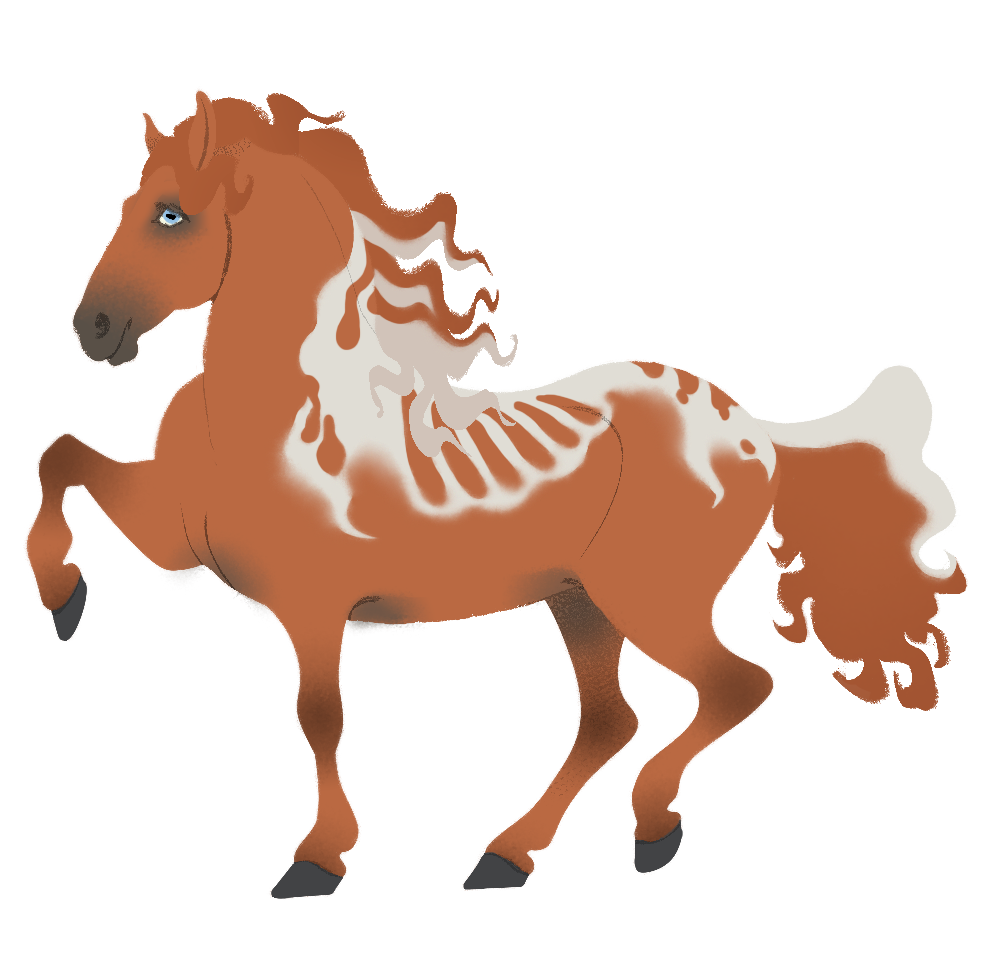

Shroud is a symmetrical white marking that descends from the horse's spine, originating anywhere from poll to tail.
Shroud should not extend further than halfway down the neck or barrel.
Jagged edges and unnatural patterns and shapes are possible, but should not be so intricate as to resemble Filigree.
Cut-outs are common, but all parts of the marking should be connected -- Shroud will not cause free-floating white.
If Shroud only touches the top of the tailbone, it may cause only the top half of the tail to be white.
Genotype: Sh_
Locus: Not shared with any known genes
- Coat: Shroud is a white marking.
- Mane and Tail: Mane will be white where marking touches.
- Skin: Pink underneath marking.
- Eyes: Can be blue despite the marking being unable to touch them
- Hooves: Shroud cannot touch the hooves.
Range:
- Minimum: A white marking that follows the horse's spine and is at least as long as the horse's head.
- Maximum: White covers the entire spine from poll to tail, and is solid from the top of the spine to the middle of the barrel/neck.





